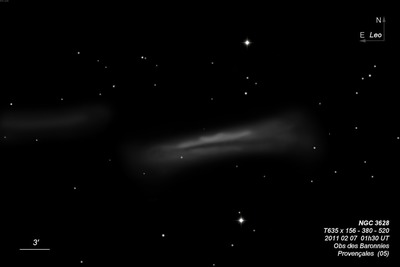
William Herschel discovered NGC 3628 = H V-8 = h859 on 8 Apr 1784 (sweep 187) and recorded "B, vmE, lbM than towards the ends. It seems to extend 9 or 10' if not more." JH called it "a v long narrow ray, vgbM; 15' long, a most curious object. E by diag in pos 105°.
Lord Rosse first observed NGC 3628 on 31 Mar or 1 Apr 1848. Samuel Hunter, observing on 10 Feb 1861, noted "split into two parallel rays." A month later he added "split extends its whole length, the f part being partially filled with faint nebulosity." Robert Ball, observing on 18 Mar 1866 also noted "there seems to be a dark channel on south side in direction of elongation."
300/350mm - 13.1" (4/24/82): the dust lane is clearly visible along the entire length and divides the galaxy into two asymmetric halves with the south slice much fainter.
400/500mm - 17.5" (1/31/87): bright, unusually large edge-on WNW-ESE, 11'x2.5'. A broad irregular dust lane is prominent bisecting the galaxy along the entire length. Appears brighter to the north of the dark lane and fainter on the south side.
900/1200mm - 48" (5/12/18): at 375x; very prominent, stunning dust lane extending along most of the length of the galaxy [for roughly 8']. The lane widens on both the WNW and ESE end. On the ESE end, the outer halo has a fairly low surface brightness and spreads or flares out in width. At the WNW end, the outer halo was easily visible and sprayed out noticeably in a wide cone, more extensively towards the north, creating an asymmetric appearance. A mag 16.5 star is along the N edge, at the brightest section, and a mag 15.5 star is 40" further NE. A brighter mag 14.8 star is along the ESE flank, 2.5' from center.
Notes by Steve Gottlieb